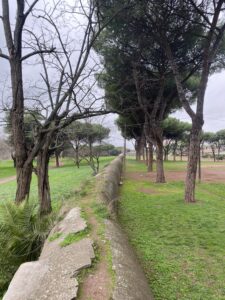Church
The first place that our group viewed was the Basilica of Saint Sebastian. Upon entering the Basilica, we were able to witness that beautiful ceiling that displayed the story of Saint Sebastian martyrdom, and symbols that emulate strength and courage. The materials of the ceiling were entire configured of wood, which was impressive because the ceiling was made in the 17th century and showcase how well preserved the components of the architecture were kept.
Additionally, some important statue are stored and preserved in the basilica such as the Bust of Saint Sebatian and the Statue of Saint Sebatian. The Bust of Saint Sebatian had an incredibly interesting history due to a huge debate that occurred between the original and a replica of the statue. Through analyzing the material used and the techniques that were implemented to carve the details the statue, people were able to differentiate the original from the decoy. This is how the original Bust of Sain Sebatian is not located and one display in the basilica to this day through analyzing the material and carving techniques.
Appian Way
After our stop at the Basilica of Saint Sebastian, the class began our walk down the Appian Way, which is one of the earliest Roman roads. It was the first road built for transporting troops outside of Rome and it is named after Appius Claudius Caecus. This road perfectly exemplifies the expression, “All roads lead to Rome”. The class was also able to take a look at the Circus of Maxentius, which hosted various ancient Roman games, typically in honor of Maxentius’ son Valerius Romulus, who died at a young age. Nearby is the tomb of Romulus, which is thought to hold his remains. As we continued down the Appian Way, we were able to witness the divots made by Roman chariots in the ancient stones. There were a number of ruins we passed by, as well as some wildlife! A little black cat and a herd of sheep said hello to the Tommies as we made our way down the road.
Aquaducts
For our final tour today, we went to aquaduct park where the remnants of two remarkable Roman aquaducts, namely Aqua Claudia and Anio Novus, are preserved. As we strolled through the park, we focused on examining the structural elements of these historical marvels. Unfortunately, it was raining outside but the temperature was very pleasant, so we weren’t affected much!
There are 11 total aquaducts in Rome, and they were designed to move water from distant sources to the heart of Rome. It took very skilled and detailed surveying and engineering for the Romans to construct these great structures! The aquaducts relied totally on gravity to move the water from source to source, so the engineers had to be very precise in the slope and inclination of the duct so it could span great lengths. These aquaducts stand as a testament to the brilliance of ancient engineering. 

No Comments